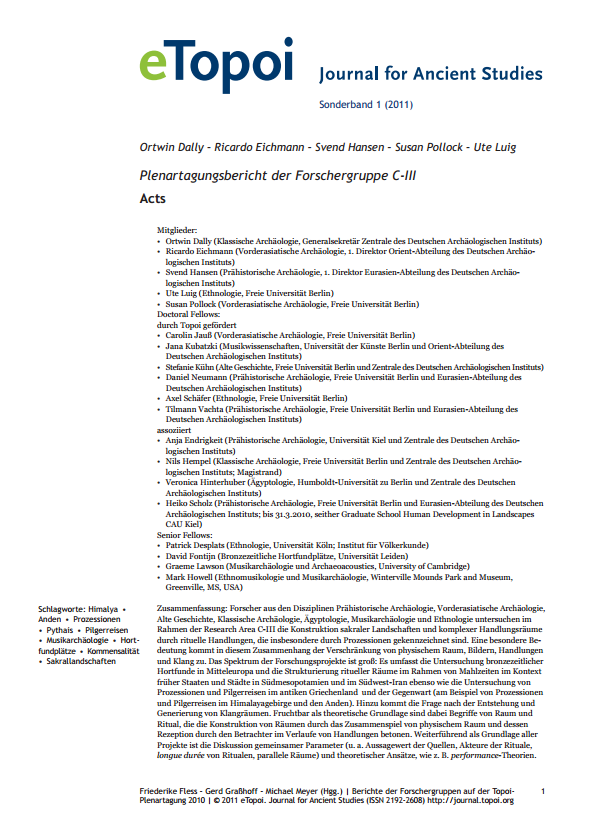Plenartagungsbericht der Forschergruppe C-III
Acts
In the framework of Research Area C-III, researchers from the disciplines of prehistoric archaeology, Near Eastern archaeology, ancient history, classical archaeology, Egyptology, music archaeology, and ethnology investigate the construction of sacred landscapes and complex spaces of action through ritual activities, and in particular those characterized by processions. Special importance is attributed to the interrelationship of physical space, imagery, actions, and sound. The spectrum of research projects is broad, and encompasses investigations of Bronze Age hoards in Central Europe; the structuring of ritual spaces in the framework of meal times in the context of the early states and cities of southern Mesopotamia and southwestern Iran; as well as investigations of processions and pilgrimages in Greek antiquity and in the present day (including, for instance, processions and pilgrimages in the Himalayan mountains and in the Andes region). Also treated is the question of the emergence and generation of acoustic spaces. Productive as theoretical bases are concepts of space and ritual which emphasize the construction of spaces through the interplay of physical space and its reception by the beholder in the course of structured actions. Fundamental to all projects, furthermore, are discussions of common parameters (including the informational value of source materials, the role of participants in rituals, the longue durée of rituals) and theoretical approaches, for example theories of performance and concepts of parallel spaces.
Forscher aus den Disziplinen Prähistorische Archäologie, Vorderasiatische Archäologie, Alte Geschichte, Klassische Archäologie, Ägyptologie, Musikarchäologie und Ethnologie untersuchen im Rahmen der Research Area C-III die Konstruktion sakraler Landschaften und komplexer Handlungsräume durch rituelle Handlungen, die insbesondere durch Prozessionen gekennzeichnet sind. Eine besondere Bedeutung kommt in diesem Zusammenhang der Verschränkung von physischem Raum, Bildern, Handlungen und Klang zu. Das Spektrum der Forschungsprojekte ist groß: Es umfasst die Untersuchung bronzezeitlicher Hortfunde in Mitteleuropa und die Strukturierung ritueller Räume im Rahmen von Mahlzeiten im Kontext früher Staaten und Städte in Südmesopotamien und im Südwest-Iran ebenso wie die Untersuchung von Prozessionen und Pilgerreisen im antiken Griechenland und der Gegenwart (am Beispiel von Prozessionen und Pilgerreisen im Himalayagebirge und den Anden). Hinzu kommt die Frage nach der Entstehung und Generierung von Klangräumen. Fruchtbar als theoretische Grundlage sind dabei Begriffe von Raum und Ritual, die die Konstruktion von Räumen durch das Zusammenspiel von physischem Raum und dessen Rezeption durch den Betrachter im Verlaufe von Handlungen betonen. Weiterführend als Grundlage aller Projekte ist die Diskussion gemeinsamer Parameter (u. a. Aussagewert der Quellen, Akteure der Rituale, longue durée von Ritualen, parallele Räume) und theoretischer Ansätze, wie z. B. performance-Theorien.

